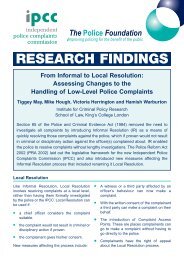Differential treatment in the youth justice system - Equality and ...
Differential treatment in the youth justice system - Equality and ...
Differential treatment in the youth justice system - Equality and ...
Create successful ePaper yourself
Turn your PDF publications into a flip-book with our unique Google optimized e-Paper software.
DIFFERENTIAL TREATMENT IN THE YOUTH JUSTICE SYSTEMevidence that discrim<strong>in</strong>ation plays a direct role <strong>in</strong> limit<strong>in</strong>g economic opportunities(Wood et al., 2009; Heath <strong>and</strong> Cheung, 2006).Unemployment among black adults is significantly higher than among whites.The social geography of educational provision too is such that children <strong>in</strong> poorercommunities are less well provided for <strong>and</strong> routes to advancement are accord<strong>in</strong>glymore constra<strong>in</strong>ed: educational underachievement is both a symptom <strong>and</strong> a causeof disadvantage. At <strong>the</strong> same time, rates of school exclusion tend to be almosttwice as high for black children, rais<strong>in</strong>g questions about whe<strong>the</strong>r different ‘tariffs’of punishments operate with<strong>in</strong> schools, <strong>and</strong> about <strong>the</strong> relevance of <strong>the</strong> nationalcurriculum to <strong>the</strong> needs <strong>and</strong> experiences of black young people. The relationshipbetween lack of educational opportunities <strong>and</strong> <strong>youth</strong> crime is well established <strong>and</strong> <strong>the</strong>particular underachievement of black boys is a ‘major cause of entry <strong>in</strong>to <strong>the</strong> crim<strong>in</strong>al<strong>justice</strong> <strong>system</strong>’ (House of Commons Home Affairs Committee, 2007: paragraph 113).The Home Affairs Committee (2007) also found that characteristics with<strong>in</strong> <strong>the</strong> blackcommunity may have <strong>the</strong> potential to compound disadvantage. Higher rates of loneparent<strong>in</strong>g, a consequent lack of appropriate male role models, <strong>and</strong> <strong>the</strong> quality ofparental discipl<strong>in</strong>e were all considered by <strong>the</strong> Committee to be problematic.Black children are also significantly over-represented <strong>in</strong> <strong>the</strong> care <strong>system</strong>,which is frequently recognised as a risk factor for offend<strong>in</strong>g.Research shows that offences such as robbery are more prevalent <strong>in</strong> poorneighbourhoods, <strong>and</strong> young people at greatest risk of <strong>in</strong>volvement <strong>in</strong> street crime live<strong>in</strong> households with no adult earners where a crim<strong>in</strong>al economy is <strong>in</strong> competition withlegitimate forms of subsistence (FitzGerald et al., 2003; FitzGerald, 2006:8). Inevidence to <strong>the</strong> House of Commons Home Affairs Committee, FitzGerald concludedthat ‘44 <strong>and</strong> 45 per cent respectively of all “mixed” <strong>and</strong> “black” respondents lived <strong>in</strong>“council estates <strong>and</strong> low <strong>in</strong>come areas” compared to 18 per cent of whites’.Traditionally, crim<strong>in</strong>ologists have tended to resist <strong>the</strong> idea that some ethnic m<strong>in</strong>oritygroups are over-<strong>in</strong>volved <strong>in</strong> offend<strong>in</strong>g. However, <strong>the</strong> weight of crim<strong>in</strong>ological <strong>the</strong>ory<strong>and</strong> research is that patterns of social exclusion must place ethnic m<strong>in</strong>ority groups atconsiderable risk of <strong>in</strong>volvement <strong>in</strong> crime. Arguably <strong>the</strong> phenomenon <strong>in</strong> need of7






